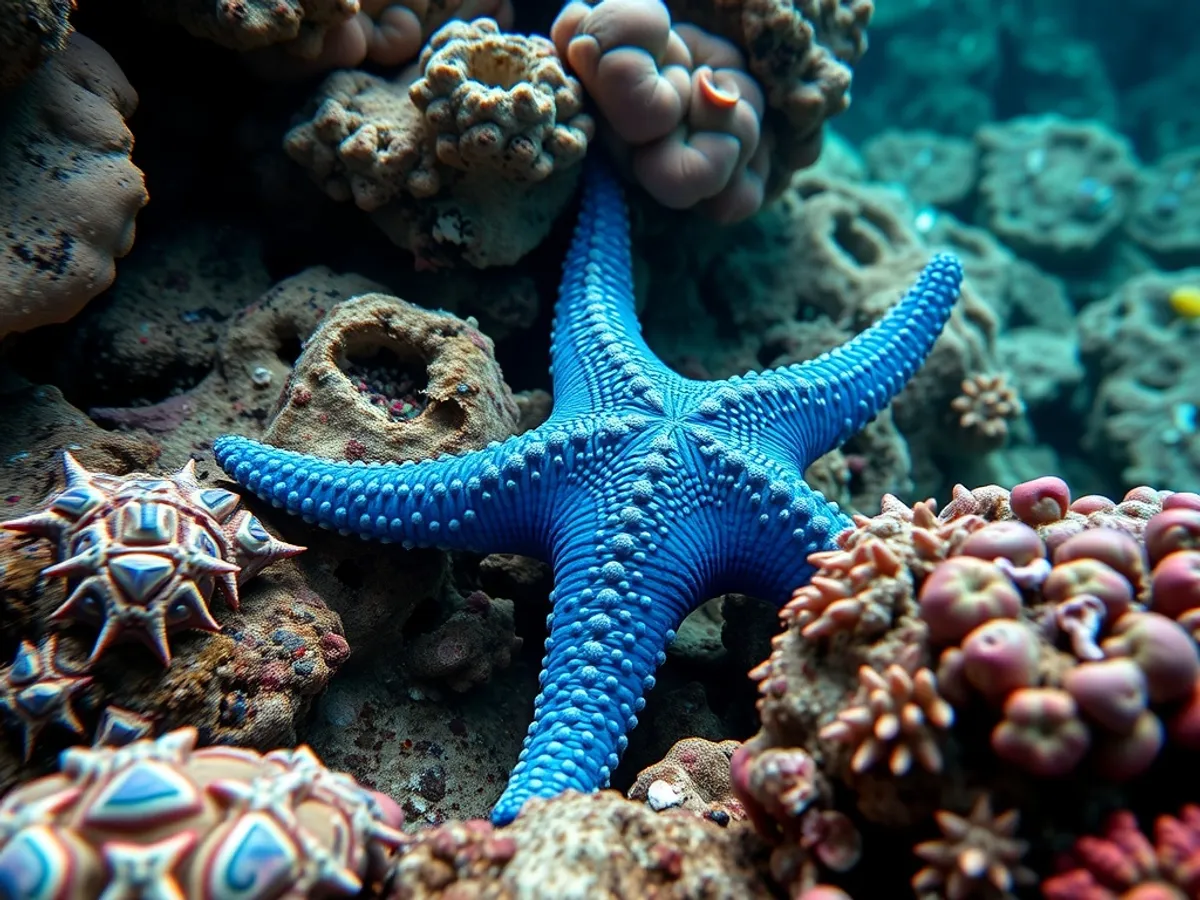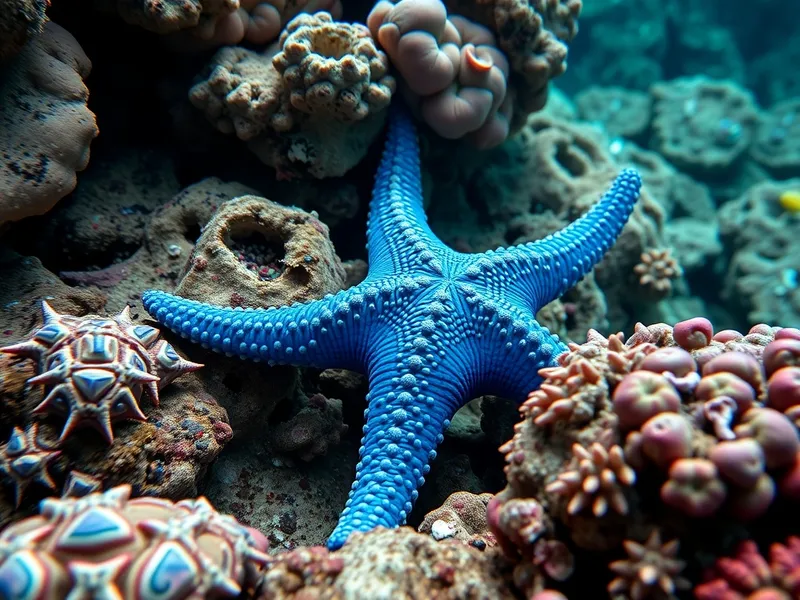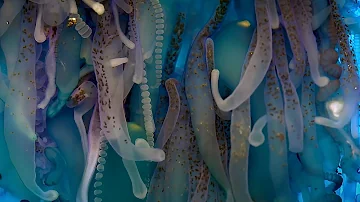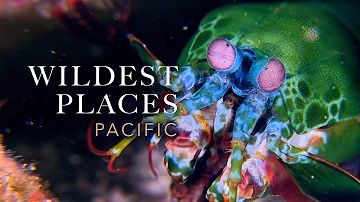
Blue Sea Star
Linckia laevigata

Meet the Blue Sea Star
The Blue Sea Star is a striking echinoderm known for its vibrant blue coloration and five slender arms. Found throughout the shallow waters of the Indo-Pacific, it is a common sight on coral reefs, sandy bottoms, and seagrass beds. This species can reach up to 30 centimeters in diameter and is known for its ability to regenerate lost limbs. Blue Sea Stars play a vital role in reef ecosystems, providing habitat for small invertebrates and participating in the food web.
Classification
Invertebrate
Habitat
Coral reefs and shallow marine environments
Diet
Omnivore
Lifespan
5-10 years
Conservation
Least Concern
Weight
70-100 grams
📖Fascinating Facts
Colorful Defense
The brilliant blue hue of Linckia laevigata may help deter predators by signaling toxicity, although they are not truly poisonous.
Home for Others
Small shrimp and other invertebrates often use the Blue Sea Star for shelter, living on or around its arms.
Regeneration Master
If an arm is lost, the Blue Sea Star can regenerate it over several months, and in rare cases, an entire new starfish may grow from a single arm.
📋Detailed Description
The Blue Sea Star (Linckia laevigata) is a visually striking echinoderm, easily recognized by its vivid blue coloration, although individuals can also display shades of aqua, purple, or even green. Its pentaradial symmetry is marked by five elongated, cylindrical arms that can reach up to 30-40 centimeters in length, though some specimens may have four or six arms due to regeneration or injury. The body surface is covered with small, granular ossicles, giving it a slightly rough texture, and tube feet line the underside of each arm, aiding in locomotion and feeding. Linckia laevigata possesses a water vascular system that facilitates movement and gas exchange. This species is primarily nocturnal, often hiding under rocks or within crevices during the day to avoid predation. It is known for its remarkable regenerative abilities, capable of regrowing entire arms or, in rare cases, forming new individuals from a single detached arm (a process known as autotomy and asexual reproduction). Blue Sea Stars are solitary but may aggregate in areas with abundant food. Their ecological role extends beyond predation and scavenging; they provide microhabitats for commensal organisms such as shrimps, copepods, and small mollusks. Their presence is considered an indicator of healthy reef systems, as they are sensitive to changes in water quality and habitat disturbance.
💡 Did you know?
Despite their bright color, Blue Sea Stars can change shades depending on their environment and age.
🔬Research & Sources
🎭Behavior & Social Structure
Blue Sea Stars are generally slow-moving, using their hundreds of tube feet to glide across the substrate in search of food. They are omnivorous scavengers, feeding on detritus, biofilm, algae, and occasionally sessile invertebrates such as sponges and small bivalves. Feeding is accomplished by everting their stomachs through their mouths to externally digest food before absorption. They exhibit cryptic behavior, often remaining hidden during daylight hours and becoming more active at dusk and night. Social interactions are minimal, with little evidence of territoriality or complex communication. However, multiple individuals may be found in close proximity in areas with abundant resources. When threatened, Linckia laevigata can autotomize (shed) an arm to escape predation, a process that also facilitates asexual reproduction.
👶Reproduction & Life Cycle
Linckia laevigata reproduces both sexually and asexually. Sexual reproduction is dioecious, with separate male and female individuals releasing gametes into the water column during synchronized spawning events, typically triggered by environmental cues such as lunar cycles and water temperature increases, often in the spring or early summer. Fertilization is external, and the resulting planktonic larvae (bipinnaria and later brachiolaria stages) drift for several weeks before settling and metamorphosing into juvenile sea stars. Asexual reproduction occurs through arm autotomy, where a detached arm (called a 'comet') can develop into a genetically identical individual, provided it contains a portion of the central disc. There is no parental care; larvae are left to develop independently in the plankton.
🛡️Adaptations & Survival
The Blue Sea Star's vivid coloration is thought to serve as a warning to potential predators, as some tissues contain saponins and other distasteful compounds. Its ability to regenerate lost arms is a key survival adaptation, allowing recovery from predation and injury. The water vascular system enables efficient locomotion and manipulation of food items. Tube feet not only aid in movement but also in adhering to surfaces in strong currents. The species' nocturnal and cryptic behaviors reduce predation risk. Its omnivorous diet and ability to exploit a wide range of food sources contribute to its ecological success across diverse reef habitats.
📚Research Sources
🎨Cultural Significance
The Blue Sea Star is often featured in local folklore and is a popular motif in Pacific Island art and jewelry, symbolizing the beauty and diversity of coral reefs. In some cultures, sea stars are considered symbols of renewal and regeneration due to their remarkable healing abilities. The species is commonly collected for the marine aquarium trade and as dried souvenirs, although this practice is increasingly regulated to prevent overexploitation.
🔬Recent Research & Discoveries
Recent research has focused on the molecular mechanisms underlying Linckia laevigata's regenerative abilities, with studies identifying key genes and cellular pathways involved in arm regrowth. Ecological studies have highlighted its role as a bioindicator for reef health, given its sensitivity to environmental changes. Ongoing research is examining the impact of ocean acidification on its calcification processes and larval development. There is also interest in the chemical compounds produced by this species, some of which have potential biomedical applications due to their antimicrobial and cytotoxic properties.
🎥Wildlife Videos

Blue Whisper - The Fascinating World Beneath the Waves | Free Documentary Nature
Blue Whisper - The Fascinating World Beneath the Waves | Ocean Documentary Watch 'Adventure Ocean Quest: Discovering ...
Free Documentary - Nature

Exploring The Underwater World | 4K UHD | Blue Planet II | BBC Earth
Travel to the depths of our mysterious oceans to discover all kinds of curious creatures underwater – from fish that communicate ...
BBC Earth

Wildest Places: Pacific Great Barrier Reef
Coral reefs are the most bio-diverse areas of the Pacific ecosystems. More than a quarter of the world's marine species live on ...
MagellanTV

Our Planet | Coastal Seas | FULL EPISODE | Netflix
Experience our planet's natural beauty and examine how climate change impacts all living creatures in this ambitious ...
Netflix

Stunning 4K Underwater Nature Footage | BBC Earth
Our oceans cover 71% of the planet, provide us with about half of our oxygen and are home to hundreds of thousands of known ...
BBC Earth

Oceans Odysseys: Incredible Animal Journeys (Full Episode) | National Geographic
Jump on board with the dedicated ocean moms risking it all to bring new life into the world. Enjoy a free trial of National ...
National Geographic
🌍Habitat Information
The Blue Sea Star typically inhabits Coral reefs and shallow marine environments environments. Blue Sea Stars have adapted to their environments with specialized features and behaviors.
Primary Habitat:
Coral reefs and shallow marine environments
More detailed habitat information will be available soon.
🛡️Conservation Status
The Blue Sea Star is currently classified as Least Concern. Conservation efforts are crucial for preserving this species for future generations.
Common Threats:
- 🏠Habitat loss and fragmentation
- 🌡️Climate change impacts
- 🎯Hunting and poaching
- 🏭Human-wildlife conflict
⚠️Threats & Conservation Challenges
Although currently listed as Least Concern by the IUCN, Linckia laevigata faces localized threats from habitat degradation, coral reef destruction, and collection for the aquarium and curio trades. Overharvesting in some regions has led to population declines. Climate change-induced coral bleaching and ocean acidification also pose indirect threats by degrading their habitats. Pollution and sedimentation can affect their food sources and reproductive success. Despite these challenges, populations remain stable in many areas, but continued monitoring is recommended.
🔬Scientific Classification
Scientific Name
Linckia laevigata
Classification Hierarchy
🔍 About Taxonomic Classification
Taxonomic classification is a hierarchical system used by scientists to classify and organize living organisms based on shared characteristics and evolutionary relationships.
The system moves from broad categories (Kingdom) to increasingly specific ones, with each animal's scientific name typically consisting of its Genus and species.
📝Community Notes
Share your observations and insights about the Blue Sea Star with our community of wildlife enthusiasts.
Join Our Community
Sign in to share your observations and connect with fellow wildlife enthusiasts.
Sign In to ContributeNo community notes yet
Be the first to share your observations about the Blue Sea Star!
Explore Blue Sea Star
Select a tab above to learn more about this amazing animal.
📸Photo Gallery
No photos available for this animal yet.
🌟Discover More Wildlife
Continue your journey of discovery with more fascinating animals from our database
